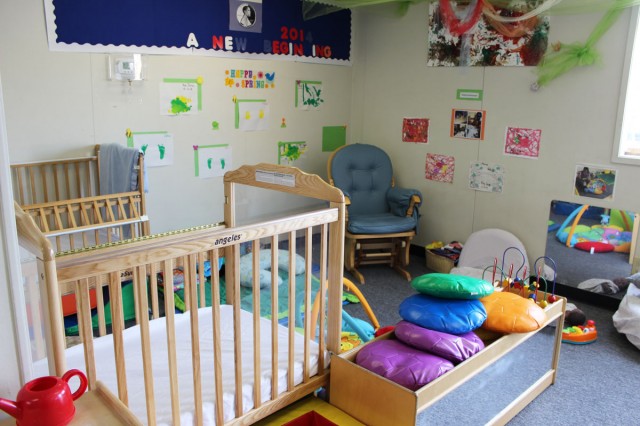Her probation officer suggested that Martinez check out a special high school for pregnant and parenting teens. The high school is run by the Alameda County branch of the California School Age Families Program, or Cal-SAFE and serves young women and men between the ages of 12-19 or grades 8-12.
Martinez, now 19, is on track to graduate from the school's Hayward campus in November with her high school diploma. While she has been finishing her education, her children, now ages 4 and 3, have been beginning theirs. As part of enrollment in the Cal-SAFE program, students must enroll their children in Early Head Start, located right on the same campus.
Parents attend class between 9 a.m. and 3 p.m. each day, and instead of worrying about their children, they can walk just a few hundred feet to check on their little ones. Parents and children are also required to spend their lunch hour together.
Martinez says the Cal-SAFE program has not only helped her get her life on track, but has also provided a way for her children to begin their lives on more solid ground. More than 73 percent of the students left the Cal-SAFE Program having successfully completed their high school education, far above the cited graduation rate for teen mothers of 30 percent, according to a 2010 report by the California Department of Education.
“This program is amazing,” Martinez said. “It’s about building support systems. Having a community here has helped me so much.
Uncertain Future
But now, the Alameda County Cal-SAFE program might be in jeopardy of losing its funding. While a major issue has been systematic budget cuts, a bigger issue might be the upcoming retirement of a key advocate for the program: Sheila Jordan, Alameda County Office of Education's superintendent.
Currently, the Alameda County Cal-SAFE program is funded primarily by the Alameda County Office of Education, with a small bit of their budget coming Average Daily Attendance money, or ADA. But it has really been the continued support of Jordan who has pledged county dollars to keep the program afloat.
“These are young women who were in school, often they’ve dropped out,” Jordan said. “It takes a lot of personal work with these young women, but the pride we have and they have in graduating is huge.”
Without Jordan's dogged commitment, the program's future is on less solid ground.
What it takes
Sitting outside in the sunny lunch area, a few young mothers feed their children vegetables or applesauce. The air is filled with giggles and cries from gaggle of toddlers playing with one another.
Physically, the program has been crafted to create a learning-conducive environment. Brightly colored drawings and other art projects are pasted on the walls of the classrooms and hallways. At both campuses huge bulletin boards advertise resources for the young parents.
According to data collected from Cal-SAFE programs, a significant majority of the children born to Cal-SAFE students were born healthy.
Principal Carolyn Hobbs administers Alameda County’s Cal-SAFE Program. She says the program gets remarkable results, especially considering the challenges backgrounds their students have coped with.
The students who come to the program are in widely different places academically. Often their living situations are precarious. In addition, many aren't prepared for the physical changes that their bodies will go through during pregnancy.
The teaching staff starts by mapping out where each student is in terms of credits and works to develop a road map to graduation.
“For many of them it’s the first time they see where they can go,” Hobbs said. “They see a light at the end of the tunnel and realize, ‘I can graduate.’”
The program also has a nurse on staff who works hard to make sure students make all of their scheduled doctor’s appointments.
The staff make themselves available for more than just questions about learning.
“We can talk to our teachers about anything,” Martinez said. “I wouldn’t have been able to go up to my math teacher at my old school and be like, ‘Hey, I’m pregnant. What do I do?’”
Hobbs acknowledges that it’s not inexpensive to fund a program like this, but she says, the investment goes far beyond the 90 students the program can serve: It helps to build generations of contributors to society.
The young people who come to the program often come from tumultuous backgrounds. In addition to academics, the Cal-SAFE program teaches these teens how to become successful parents with classes on parenting skills, proper nutrition, even budgeting skills. The program enhances students' world view, showing students that they can achieve more for themselves and their children.
“Where do you put your money?” Hobbs says. “You could be pennywise and pound foolish. But consider the costs of incarceration versus education.”
Martinez says she’s seen a huge improvement in the cognitive abilities of her own children. They can sing the alphabet, name colors, and sing songs together.
“They surprise me sometimes,” she said. “I think ‘you’re not going to be able to do it.’ And they do it. I feel like they’re going to be the smartest kids in the world.”
